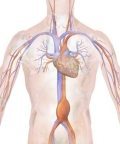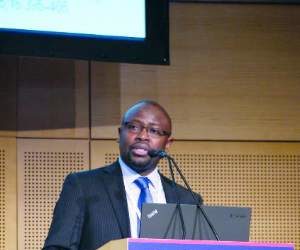AT EHA 2017
MADRID (FRONTLINE MEDICAL NEWS) – Monotherapy with the investigational oral agent enasidenib was associated with comparatively high response rates among patients with heavily pretreated relapsed or refractory acute myeloid leukemia (AML) and IDH2 mutations in a phase 1/2 study.
Among 214 patients treated at a dose level of 100 mg daily, the overall response rate was 37%, including 20.1% complete responses (CRs) and 7.9% complete responses with incomplete recovery of platelets (CRp) or incomplete hematologic recovery (CRi), reported Eytan M. Stein, MD , an internist and hematologic oncologist at the Memorial Sloan Kettering Cancer Center in New York.
“In patients with relapsed/refractory AML (with IDH2 mutations), most of whom had received multiple prior AML treatments, enasidenib induced durable CRs that were associated with overall survival of greater than 8 months,” he said at the annual congress of the European Hematology Association.
The IDH2 gene encodes for isocitrate dehydrogenase 2, which is an enzyme of the citric acid cycle. An estimated 8%-15% of patients with AML have mutations in IDH2 that cause intracellular accumulation of beta-hydroxyglutarate, which leads to blockage of myeloblast differentiation through a variety of mechanisms. The primary mechanism of action of enasidenib appears to be through its action on differentiation, rather than through cytotoxicity, Dr. Stein said.
He reported updated results from the fully enrolled cohorts of the phase 1/2 study. Earlier data from the study were reported at the 2017 annual meeting of the American Society of Clinical Oncology and in a paper published concurrently in Blood.
In the study, the investigators first enrolled 113 patients with advanced hematologic malignancies with IDH2 mutations and treated them with cumulative daily doses of enasidenib ranging from 50 to 650 mg.
In a phase 1 expansion study at the established dose of 100 mg daily, 126 patients with IDH2 mutations were enrolled in one of four cohorts: patients aged 60 or older with relapsed or refractory AML or AML patients of any age who experienced a relapse after undergoing a bone marrow transplant (BMT); patients under age 60 except those with post-BMT relapses; patients with previously untreated AML who were 60 years or older who declined the standard of care; and patients with other hematologic malignancies who were ineligible for other study arms.
The study also included a phase 2 expansion cohort of 106 patients with relapsed/refractory AML with IDH2 mutations treated with enasidenib 100 mg daily. The data cutoff was Oct. 14, 2016.
Among 214 patients treated at the 100-mg/day dose, the ORR was 37%, including 20.1% with a CR, 7.9% with a CRp or CRi, 3.7% with partial responses, and 5.1% with a morphologic leukemia-free state.
The median time to first response was 1.9 months, and the median time to CR was 3.7 months.
Clinicians should wait until patients have received at least four cycles of the drug before determining whether they should be continued on the drug or switched to another therapy, Dr. Stein said.
After 30 months of follow-up, overall survival (OS) among the 281 patients with relapsed/refractory AML with IDH2 mutations who were treated with enasidenib at any dose level was 8.4 months. Among the 214 treated at the 100-mg daily dose level, the median OS was 8.3 months.
When the investigators looked at OS by best response, they saw that patients who had a CR had a median OS of 22.9 months. For patients with responses other than CR, the median OS was 15.1 months. For patients with no response to the drug, the median OS was 5.6 months.
Patients generally tolerated the drug well. Most adverse events were grade 1 or 2 in severity.
An increase in blood bilirubin was the most frequent grade 3 or 4 adverse event, occurring in 8% of all patients. The effect was caused by an off-target reaction and was not associated with elevations in liver enzymes or evidence of liver damage, Dr. Stein said.
Grade 3 or 4 dyspnea occurred in 6% of patients, and 7% of all patients had serious treatment-related IDH-inhibitor–associated differentiation syndrome (IDH-DS). This syndrome presents with symptoms similar to those of retinoic acid syndrome, which occurs during treatment for acute promyelocytic leukemia.
Enasidenib is being explored in a phase 3 study comparing enasidenib monotherapy with conventional care in patients with late-stage AML and in combination with other agents and regimens in phase 1/2 studies in patients with newly diagnosed AML with IDH2 mutations.
Enasidenib has been granted priority review by the U.S. Food and Drug Administration for relapsed/refractory AML with an IDH2 mutation and has been given a Prescription Drug User Fee Act action date of Aug. 30, 2017, according to Celgene .
The study was funded by Celgene. Dr. Stein disclosed a consulting/advisory role with the company, research funding, and travel expenses.






